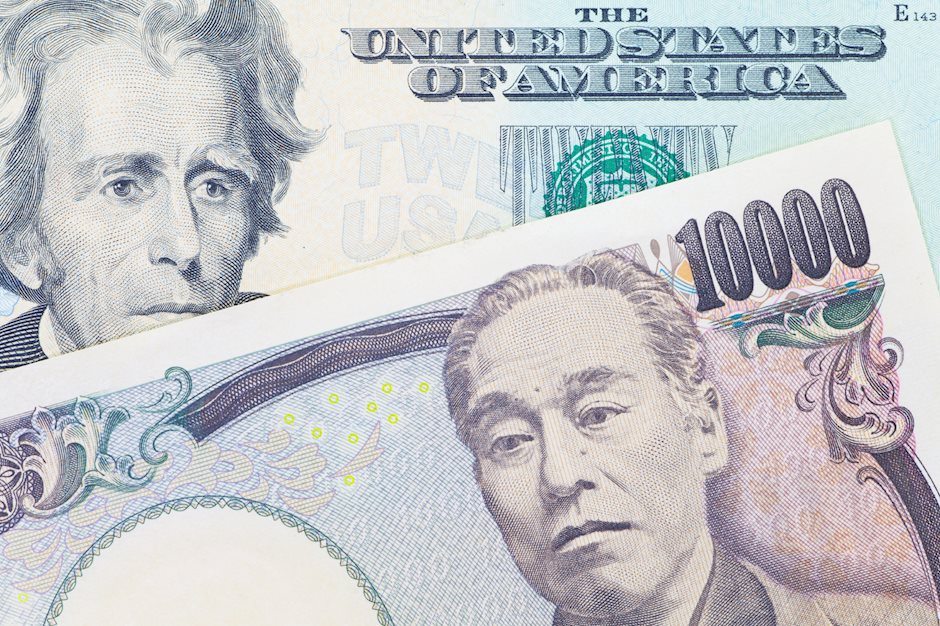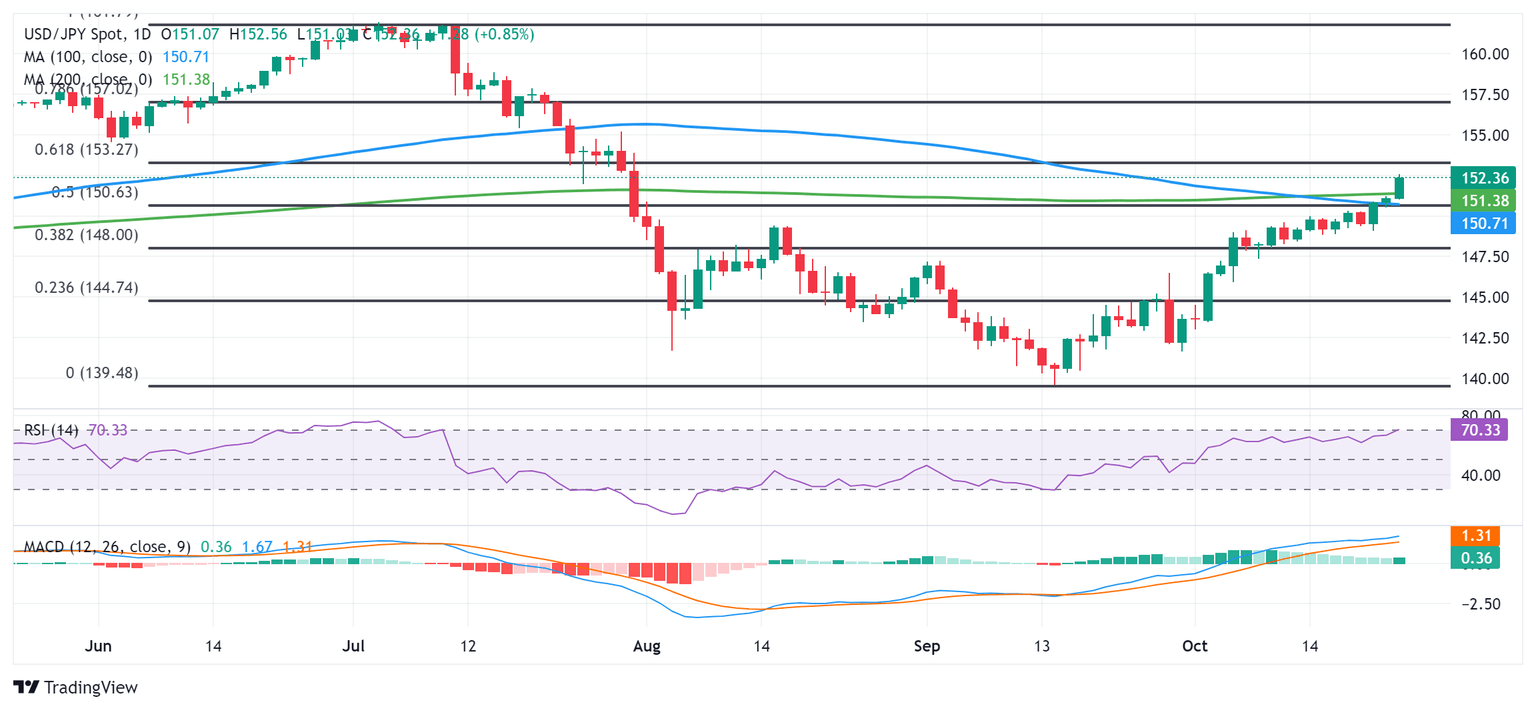USD/JPY Price Forecast: Breakout through key hurdles favors bulls amid BoJ uncertainty
- USD/JPY scales higher for the third straight day and rallies to a nearly three-month high.
- The BoJ rate-hike uncertainty weighs heavily on the JPY ahead of Japan’s snap election.
- Bets for smaller Fed rate cuts underpin the USD and further lend support to the major.

The Japanese Yen (JPY) continues with its relative underperformance on Wednesday and slumps below the 152.00 mark against its American counterpart for the first time since July 31. In the absence of any verbal intervention by Japanese authorities, the uncertainty over the timing and pace of further interest rate hikes by the Bank of Japan (BoJ) is seen weighing heavily on the JPY. Furthermore, recent opinion polls indicate that Japan's ruling Liberal Democratic Party (LDP) could lose its majority after the upcoming general election on October 27. This further raises doubts over the BoJ's ability to hike interest rates further this year and should continue to weigh heavily on the JPY.
The US Dollar (USD), on the other hand, prolongs its recent upward trajectory witnessed since the beginning of this month and climbs to its highest level since early August amid the prospects of slower rate cuts by the Federal Reserve (Fed). The CME Group's FedWatch Tool points to a nearly 90% chance that the US central bank will lower borrowing costs by 25 basis points at its next monetary policy meeting in November. Meanwhile, odds of the former President Donald Trump winning the November 5 US Presidential election fuel speculations about the launch of potentially inflation-generating tariffs. This could further force the Fed to adopt a less aggressive policy-easing stance.
Meanwhile, the outlook has been a key factor behind the recent upswing in the US Treasury bond yields, to their highest level in three months. This might continue to underpin the USD and validate the near-term negative outlook for the lower-yielding JPY, suggesting that the path of least resistance for the USD/JPY pair is to the upside. That said, the prevalent risk-off environment, along with persistent geopolitical risks stemming from the ongoing conflicts in the Middle East, could offer some support to the safe-haven JPY and cap gains for the currency pair. Nevertheless, the fundamental backdrop suggests that any meaningful corrective slide might still be seen as a buying opportunity.
Technical Outlook
From a technical perspective, Tuesday's breakout above the 150.65 confluence resistance and a subsequent move beyond the very important 200-day Simple Moving Average (SMA) was seen as a fresh trigger for bullish traders. That said, the Relative Strength Index (RSI) is flashing slightly overbought conditions on the daily chart and warrants some caution. Hence, it will be prudent to wait for some near-term consolidation or a modest pullback before positioning for the next leg up. Nevertheless, the USD/JPY pair seems poised to climb further towards reclaiming the 153.00 round-figure mark and test the next relevant hurdle near the 153.35 region, representing the 61.8% Fibonacci retracement level of the July-September downfall.
On the flip side, the 152.00 mark now seems to protect the immediate downside, below which the corrective decline could extend further towards the 200-day SMA, currently pegged near the 151.35-151.30 region. Any further slide towards the 151.00 round figure could be seen as a buying opportunity, which, in turn, should help limit losses for the USD/JPY pair near the 150.65 confluence resistance breakpoint. The latter comprises the 100-day SMA and the 50% Fibo. level, which should act as a key pivotal point and a strong short-term base. A convincing break below, however, will suggest that the upward momentum has run out of steam and shift the bias in favor of bearish traders.
USD/JPY daily chart
Bank of Japan FAQs
The Bank of Japan (BoJ) is the Japanese central bank, which sets monetary policy in the country. Its mandate is to issue banknotes and carry out currency and monetary control to ensure price stability, which means an inflation target of around 2%.
The Bank of Japan embarked in an ultra-loose monetary policy in 2013 in order to stimulate the economy and fuel inflation amid a low-inflationary environment. The bank’s policy is based on Quantitative and Qualitative Easing (QQE), or printing notes to buy assets such as government or corporate bonds to provide liquidity. In 2016, the bank doubled down on its strategy and further loosened policy by first introducing negative interest rates and then directly controlling the yield of its 10-year government bonds. In March 2024, the BoJ lifted interest rates, effectively retreating from the ultra-loose monetary policy stance.
The Bank’s massive stimulus caused the Yen to depreciate against its main currency peers. This process exacerbated in 2022 and 2023 due to an increasing policy divergence between the Bank of Japan and other main central banks, which opted to increase interest rates sharply to fight decades-high levels of inflation. The BoJ’s policy led to a widening differential with other currencies, dragging down the value of the Yen. This trend partly reversed in 2024, when the BoJ decided to abandon its ultra-loose policy stance.
A weaker Yen and the spike in global energy prices led to an increase in Japanese inflation, which exceeded the BoJ’s 2% target. The prospect of rising salaries in the country – a key element fuelling inflation – also contributed to the move.
Premium
You have reached your limit of 3 free articles for this month.
Start your subscription and get access to all our original articles.
Author

Haresh Menghani
FXStreet
Haresh Menghani is a detail-oriented professional with 10+ years of extensive experience in analysing the global financial markets.


















